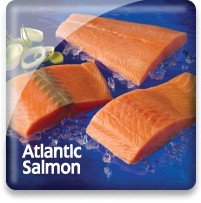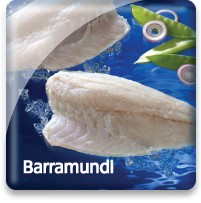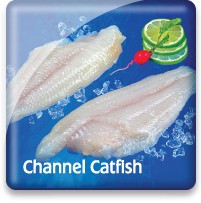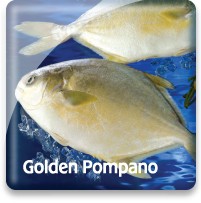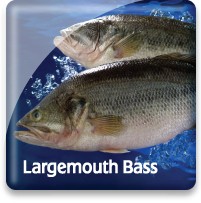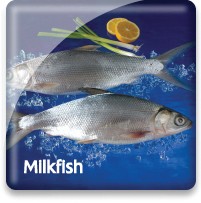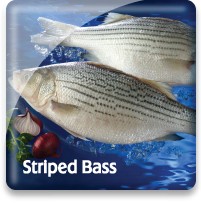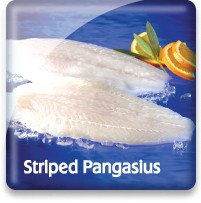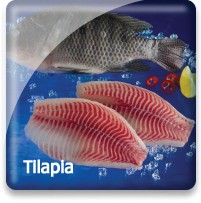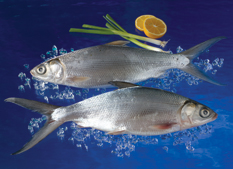
Milkfish

Market Name: Eating QualitiesThe pink flesh is rather soft, mild-tasting and contains numerous small bones which must be either expertly deboned or pressure-cooked until the bones are soft enough to eat.
Milkfish have no teeth and feed primarily on algae and invertebrates.
Almost all milkfish on the market is farmed – very little wild milkfish is caught in natural waters.
|
Description & CharacteristicsMilkfish (Chanos chanos) is an important fish in Southeast Asia. Milkfish have a generally symmetrical and streamlined appearance, with a sizable forked caudal fin. They can grow to 1.7 m, but are most often about 1 meter in length. They have no teeth and generally feed on algae and invertebrates. Milkfish is considered one of the oldest farmed species of fish in Asia. Its ability to thrive in varying water conditions make it an ideal fish to be grown in the confines of an inland pond or a cage out in the sea. Milkfish is an extremely “bony” fish. Its white meat has a mild flavor that makes the fish good for a variety of cooking preparations. Milkfish is usually fried, made into soup and even char-grilled. Milkfish, Chanos chanos, is a large herring-shaped fish. In the wild, its distribution is restricted to either low latitude tropics or the subtropical northern hemisphere along the continental shelves and around islands, where temperatures are greater than 20 degrees Celsius. Milkfish have a spindle-like shape that is moderately compressed, smooth and streamlined. Its body color is silvery on the belly and sides, grading to olive green or blue on the back. The wild catch is limited to just slightly more than one percent of total world production. First farmed around 800 years ago in the Philippines and Indonesia, global annual aquaculture production of milkfish has increased every year since 1997; by 2010 it had risen to 808,559 metric tons. In comparison, 467,666 MT were produced globally in 2000. Milkfish remains one of the world's most important farmed fish species. The milkfish is a staple in the Philippines and parts of Indonesia. The most important producers at this time are Indonesia and the Philippines, which combined account for slightly more than 95 percent of global aquaculture production. Milkfish are farmed by trapping fry on the coastal beaches, lagoons and estuaries where the adults spawn. The fry are then raised in sea cages, saline ponds or concrete tanks. Milkfish are generally marketed commercially under two pounds.The pink flesh is rather soft and widely consumed in Southeast Asia where it has been farmed for centuries. The mild meat has numerous small bones that must first be expertly deboned; according some sources even the most skilled worker may require twenty minutes for each fish. An alternative to deboning is to pressure-cook the fish until the bones are soft enough to eat. Despite these disadvantages, milkfish is extremely popular in Southeast Asia, where it is an important source of protein. Its use has become more common in the United States in recent years; especially in Asian communities where traditional spice and preparations compensate for its mild flavor. The meat can also be used for sashimi, fish cakes and fish balls.
Other ResourcesCultured Aquatic Species Information Programme http://www.all-fish-seafood-recipes.com/index.cfm/recipe/Grilled_Milkfish_(Inihaw_na_Bangus) |
Handling Instructions for Milkfish
Whole frozen milkfish (also called bangus) must be stored at or below 0°F (-18°C) and then thawed properly when ready to cook. The frozen shelf life is 18 months. Links to proper seafood handling instructions: NOAA - Fish Watch: Handling Seafood and A Consumer Guide to Safe Seafood Handling.
Thawing Milkfish
The whole IQF milkfish should be placed in a tight fitting plastic bag or covered container and placed under refrigeration between 33 and 39°F for 12-24 hours or until thawed. Gutting the whole fish once the gut cavity has sufficiently thawed is recommended even if the body of the fish is still mostly frozen. The whole fish can then be allowed to further thaw in the refrigerator.
Important Instructions for Milkfish
Upon thawing, whole fish should be gutted if not already done so when the gut cavity was partially thawed earlier in the thawing process. Once totally thawed and cleaned the fish should be cooked immediately for the best quality results. Fish not immediately consumed should be held under proper refrigeration and completely consumed within 1-2 days.
The Federal Food, Drug and Cosmetic Act now requires that all foods that are not raw agricultural commodities and that contain a major food allergen be labeled to clearly identify the name of the food source form which the allergen is derived. (21 CFR U.S.C. 343(w)(1)). The act defines eight foods, and any ingredients derived from these foods as major food allergens: Fish, Crustacean Shellfish, Milk, Eggs, Tree Nuts, Peanuts, Wheat & Soybeans. The name of the food source that must be listed on the label for fish or crustacean shellfish must be the specific type of fish or crustacean shellfish. The market names of species of fish and crustacean shellfish should be used to identify the food source of these two major food allergens. If you intend to re-pack these seafood products, be sure the allergen is declared in either one of two ways:
1) Within the list of ingredients
or
2) In a separate “Contains” statement immediately after or adjacent to the list of ingredients.
Consult the Fish and Fishery Products Hazards and Controls Guidance, Fourth Edition, Chapter 19 for more detailed information on the labeling of food allergens.
Cooking Tips
Milkfish can be prepared using a wide variety of cooking methods. Link to cooking tips and recipes.
Taiwan
The island of Tawian, shaped like a tobacco leaf, nation, is located off the coast of China where it is officially part of the Republic of China. Some 23 million people live in an area that is just 245 miles long and 89.5 miles wide, making Taiwan the second-most densely populated country in the world.
While it offers few opportunities for recreational fishing, Taiwan’s commercial fishing industry is well-established, with a fleet of vessels that fish around the world for tuna, sharks, herring, reef fish, horse mackerel, sardines, squid and octopus. Aquaculture is also an important new industry in Tawian, with freshwater farms growing shrimp farms, and tilapia, and marine farms growing shellfish such as clams and oysters.
Go Blue! Seafood Sustainability Spectrum*Click here for an explanation of our Sustainability Spectrum 
Sustainability AssessmentMilkfish has been farmed in parts of Asia for more than 700 years and is one of the most important farmed fish species in Asia. Milkfish is well suited to farming as it grows well on feeds that contain minimal amounts of marine ingredients, breeds easily, is relatively resistant to disease, and can tolerate a broad range of water qualities. Milkfish is also commonly farmed in its native range, reducing potential ecosystem impacts from escaped fish. Overall, Milkfish can be raised with minimal environmental impact.
While Milkfish as a species can be farmed with low environmental impacts, the performance of individual fish farms can vary. Impacts such as pollution and habitat damage may occur from farms that are not well-managed, especially in regions where regulatory controls are not as strictly enforced. The technology for Milkfish farming is well developed, but has not been improving at the same rate as other species, such as tilapia. As a result, this potentially environmentally beneficial species is not as economically positive for farmers as it once was. 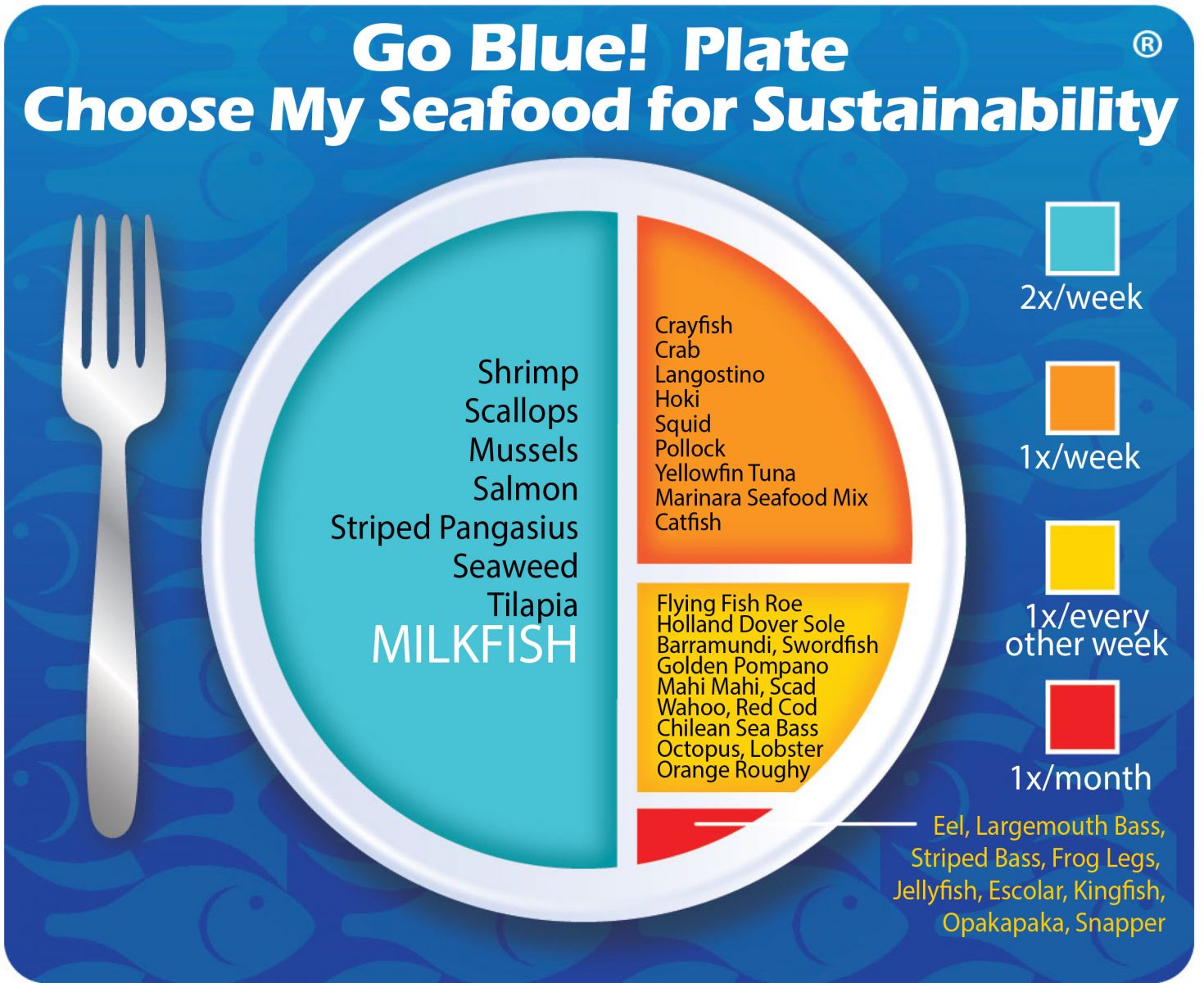
Environmental Impact: Moderate to LowMilkfish, as a species to farm, has several beneficial attributes including hardiness, good growth on feeds that contain small amounts of marine resources, and disease resistance. Poor production practices may reduce these benefits in regions where regulation and enforcement may not fully ensure protection from environmental impacts, such as pollution.
Sustainability Improvements NeededOverall, the Milkfish farming industry needs to innovate to improve efficiencies in production. Best management practices could be assured at all farms through more effective and enforced, regulations.
Actions that Sea Port is UndertakingSea Port is promoting the consumption of farmed Milkfish based on our belief that a wide variety of farmed seafood holds the best promise to relieve pressure on our wild fisheries while increasing the availability of high quality and healthy seafood. Milkfish certainly adds to this variety and does so with a reduced negative environmental impact. Sea Port believes that, in aggregate, choosing from a diverse variety of seafood is better for sustaining the world’s seafood resources and Farmed Milkfish should be a part of this variety.
We created the sustainability assessments for each of our seafood items in order to reveal the existing and potential environmental impacts and risks that are associated with producing them for human consumption. This allowed us to establish the starting position for each of our seafood items along our progressive Go Blue! Seafood Sustainability Spectrum®. These assessments are only a single snapshot in time and because of this, we will continue to assess and update the critical sustainability needs associated with our supply sources and issue updates to the Go Blue! Seafood Sustainability Spectrum® as needed. There is a growing global awareness for the need to assure the sustainability of farmed and wild caught seafood and because of this; all around the world positive changes are rapidly occurring at all levels of the seafood supply chain. We will continue to spread this growing awareness and work with our many industry partners to improve the sustainability of all seafood, which we believe is the ideal protein of choice to feed an ever growing world population. Our Go Blue! Seafood Sustainability Spectrum® serves as our compass and yardstick as we strive to move all our products forward to becoming more sustainable. Please join us in this committed quest and Catch Our Wave® to sustainability by choosing a diverse variety of responsibly produced seafood as part of your diet.
|


